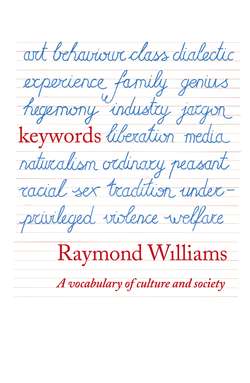Читать книгу Keywords: A Vocabulary of Culture and Society - Raymond Williams - Страница 38
CRITICISM
ОглавлениеCriticism has become a very difficult word, because although its predominant general sense is of fault-finding, it has an underlying sense of judgment and a very confusing specialized sense, in relation to art and literature, which depends on assumptions that may now be breaking down. The word came into English in eC17, from critic and critical, mC16, fw criticus, L, kritikos, Gk, rw krités, Gk – a judge. Its predominant early sense was of fault-finding: ‘stand at the marke of criticisme … to bee shot at’ (Dekker, 1607). It was also used for commentary on literature and especially from lC17 for a sense of the act of judging literature and the writing which embodied this. What is most interesting is that the general sense of fault-finding, or at least of negative judgment, has persisted as primary. This has even led to the distinction of appreciation as a softer word for the judgment of literature. But what is significant in the development of criticism, and of critic and critical, is the assumption of judgment as the predominant and even natural response. (Critical has another specialized but important and persistent use, not to describe judgment, but from a specialized use in medicine to refer to a turning point; hence decisive. Crisis itself has of course been extended to any difficulty as well as to any turning point.)
While criticism in its most general sense developed towards censure (itself acquiring from C17 an adverse rather than a neutral implication), criticism in its specialized sense developed towards TASTE (q.v.), cultivation, and later CULTURE (q.v.) and discrimination (itself a split word, with this positive sense for good or informed judgment, but also a strong negative sense of unreasonable exclusion or unfair treatment of some outside group – cf. RACIAL). The formation which underlies the most general development is very difficult to understand because it has taken so strong a hold on our minds. In its earliest period the association is with learned or ‘informed’ ability. It still often tries to retain this sense. But its crucial development, from mC17, depended on the isolation of the reception of impressions: the reader, one might now say, as the CONSUMER (q.v.) of a range of works. Its generalization, within a particular class and profession, depended on the assumptions best represented by taste and cultivation: a form of social development of personal impressions and responses, to the point, where they could be represented as the STANDARDS (q.v.) of judgment. This use seems settled by the time of Kames’s Elements of Criticism (1762). The notion that response was judgment depended, of course, on the social confidence of a class and later a profession. The confidence was variously specified, originally as learning or scholarship, later as cultivation and taste, later still as SENSIBILITY (q.v.). At various stages, forms of this confidence have broken down, and especially in C20 attempts have been made to replace it by objective (cf. SUBJECTIVE) methodologies, providing another kind of basis for judgment. What has not been questioned is the assumption of ‘authoritative judgment’. In its claims to authority it has of course been repeatedly challenged, and critic in the most common form of this specialized sense – as a reviewer of plays, films, books and so on – has acquired an understandably ambiguous sense. But this cannot be resolved by distinctions of status between critic and reviewer. What is at issue is not only the association between criticism and fault-finding but the more basic association between criticism and ‘authoritative’ judgment as apparently general and natural processes. As a term for the social or professional generalization of the processes of reception of any but especially the more formal kinds of COMMUNICATION (q.v.), criticism becomes ideological not only when it assumes the position of the consumer but also when it masks this position by a succession of abstractions of its real terms of response (as judgment, taste, cultivation, discrimination, sensibility; disinterested, qualified, rigorous and so on). The continuing sense of criticism as fault-finding is the most useful linguistic influence against the confidence of this habit, but there are also signs, in the occasional rejection of criticism as a definition of conscious response, of a more significant rejection of the habit itself. The point would then be, not to find some other term to replace it, while continuing the same kind of activity, but to get rid of the habit, which depends, fundamentally, on the abstraction of response from its real situation and circumstances: the elevation to ‘judgment’, and to an apparently general process, when what always needs to be understood is the specificity of the response, which is not an abstract ‘judgment’ but even where including, as often necessarily, positive or negative responses, a definite practice, in active and complex relations with its whole situation and context.
See AESTHETIC, CONSUMER, SENSIBILITY, TASTE
